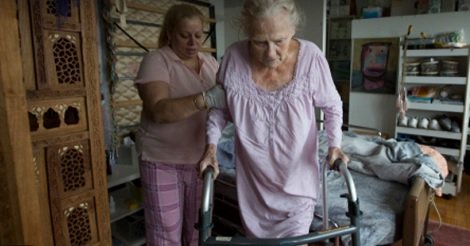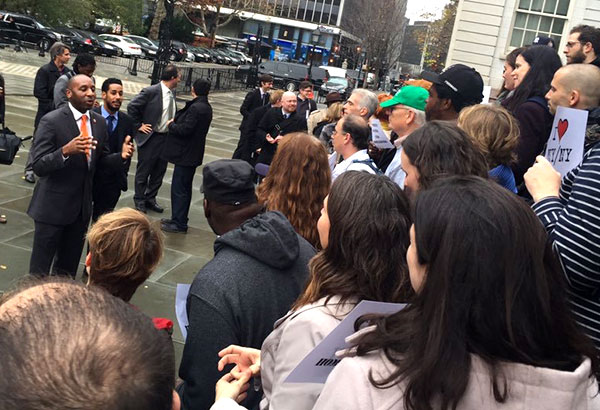Home Care Workers Need a Dedicated Advocate

photo via PHI
Nearly 175,000 New York City residents go to work each day in the homes of New Yorkers who are elderly or living with disabilities. Predominantly immigrant women of color, these aides assist with personal care, medications and other health-related tasks, meals, housekeeping, and a variety of other activities. They are crucial to keeping people who are frail or suffering from chronic illnesses healthy, safe, and independent. They have become vital to system reform efforts intended to improve the health of New Yorkers while also reducing costly and unnecessary visits to emergency rooms.
Home care workers, who may be home health aides or personal care aides, comprise the single largest occupational group in New York City. Nonetheless, they have a long history of marginalization: poverty-level wages, lack of standard labor protections, part-time hours, insufficient training and support on the job. That situation is beginning to change as policymakers recognize that the city faces a potential care crisis: a rapidly growing older population that requires a stable, skilled workforce to provide home care services.
Over the past five years, a raft of new federal, state, and local regulations - Wage Parity for personal care and home health aides, Domestic Workers Bill of Rights, and expansion of Fair Labor Standards Act to include home care aides - have been put in place to raise wages and improve working conditions. In addition, home care aides are affected by the rising minimum wage and new paid leave regulations. These measures are critical to improving the quality of home care jobs and attracting new workers, but they also have created a level of complexity that makes it difficult for employers to comply and for workers to know their rights.
The Wage Parity law requires that a home care aide be paid $10 per hour during the time she is with her client. She is paid minimum wage, currently $9 an hour, for travel time between clients. If her total number of weekly hours, including travel, is 45 hours, she must be paid time-and-a-half on her base wage for the hours over 40. The employer must calculate the base wage using a formula that accounts for hours worked ($10/hour) and paid travel time ($9/hour). How is this worker able to determine if she is being paid the right amount? What if she has an overnight shift? For how many hours should she be paid, and at what wage?
Both employers and home care aides need an unbiased source of information and assistance to navigate these rules and regulations. That is why PHI supports the proposal to include a Division of Paid Care, with a public advocate devoted to supporting the home care and day care workforces, in the new city Office of Labor Standards. For New York City’s home care workforce, this office could offer several crucial services:
Education: Assist home care workers and their employers in learning about labor laws and regulations. For example, the advocate could spearhead public education on rules regarding compensation and labor protections. The advocate would also be available via a toll-free number to answer any questions workers had about their rights.
Tracking and Reporting: Create a system for reporting complaints, cataloguing questions, and providing timely answers to frequently asked questions. An effective system would provide workers with a supportive environment in which to learn about their rights and file a complaint, if warranted. The advocate could track complaints and issue an annual report describing type and frequency, and propose appropriate measures to reduce violations.
Assistance and Support: Help workers access state and local services for low-wage workers - for example, connecting workers to child care or health care resources. In addition, the advocate could provide information on available training programs and their costs.
To keep up with growing demand, it is estimated that New York City will need to grow its home care workforce 45 percent - more than 72,000 workers - over the next decade. To ensure quality home care services, New York City also needs to increase retention of well-trained, experienced aides. A Division of Paid Care could help to ensure quality jobs, with fair pay and adequate support, making home care a more attractive career for thousands of workers who could easily choose fast-food or other jobs over caring for the city’s most vulnerable elders.
***
Carol A. Rodat is the New York Policy Director for PHI, a national nonprofit affiliated with a New York health care system that includes Cooperative Home Care Associates, a worker-owned home care agency, and Independent Care System, a managed-care organization. On Twitter @PHInational.
***
Have an op-ed idea or submission for Gotham Gazette? Email This email address is being protected from spambots. You need JavaScript enabled to view it.
Top 10 Accomplishments of Progressive Leadership & The Need to #ProtectProgress

Council Members Richards, left, and Reynoso, the authors, address a crowd
As co-chairs of the New York City Council’s Progressive Caucus, we have worked closely with Mayor de Blasio since he took office. It is clear that the mayor has delivered for our constituents and all 8.4 million New Yorkers in transformative ways. From affordable housing to quality jobs to expanded educational programming, New Yorkers are doing better and the scale of the accomplishments is substantial.
In partnership with our Speaker, Melissa Mark-Viverito, and the City Council, Mayor de Blasio has been helping to create a more equitable New York City. But this progress did not happen by chance, and it’s no foregone conclusion that we will be able to sustain it. We cannot allow our momentum to be derailed, destabilized, or diminished.
Under a boldly progressive mayor and Council speaker, New York is safer and public policy is more equitable than at any point in our lifetimes. We must protect our progress, join us as we launch our #ProtectProgress campaign, which includes the following highlights of this work, the Top 10 Accomplishments, by the Numbers:
1. Making Communities Safer: With two consecutive years of record low violent crime statistics, New York is the safest big city in the country.
2. Making Pre-K Universal: More than 68,500 children are getting the head start they deserve this year with full day pre-kindergarten classes for all of New York’s four-year-olds.
3. Developing and Preserving Affordable Housing: Over 100,000 New Yorkers have access to 40,000-plus new units of affordable housing. More affordable housing units were created in 2015 than in any year since the city’s housing department began.
4. Creating Economic Growth: More New York City jobs than ever before, totaling 4,296,100 across all five boroughs as of March 2016. This includes 254,900 new private sector jobs created during this administration, resulting in an unemployment rate of 6.1%, lower than other large cities like Chicago, Los Angeles, and Philadelphia. This is in part due to new legislation preventing discrimination against job seekers based on credit scores and prior convictions.
5. Improving Police-Community Relations: Reducing unlawful stop-and-frisks, which disproportionately affect African-American & Latino New Yorkers with a 97% decline over four years.
6. Expanding Learning Time: The Mayor’s universal after-school program for 113,874 middle school students (double the number previously served) is providing quality programming during a critical time for childhood development.
7. Embracing Immigrant Communities: IDNYC enables non-citizens to participate in the civic and cultural life of the city, with 855,000-plus cardholders who have secured the peace of mind that comes from recognized government identification.
8. Extending New Yorkers’ Legal Right to Sick Leave: 3,400,000 private and nonprofit sector workers have access to paid sick leave thanks to an expansion created in partnership with the Council and the Mayor’s robust education campaign.
9. Making Streets Safer through Vision Zero: In 2015, New York City saw the fewest traffic fatalities in history, with a 22% reduction resulting from reduced speed limits and comprehensive safety plans.
10. Supporting a Living Wage: A $15 living wage is now guaranteed to every City worker and employee of nonprofit organizations contracted with the City, and the Mayor and Council have advocated for higher wages for all workers across the state.
We must be proud of these accomplishments while we also build on them. Today, we call on progressives from Bushwick to Harlem, from the Rockaways to Riverdale to step and up and #ProtectProgress. Parents: tweet from your UPK sites that didn’t exist two years ago! Bicyclists: tweet images of your new protected lanes that are helping to save lives! IDNYC cardholders: tweet from wherever you are putting your card to use!
Let’s get #ProtectProgress into the conversation, so that together we can promote real results that Mayor de Blasio and the City Council have delivered for New Yorkers.
***
City Council Members Antonio Reynoso and Donovan Richards are co-chairs of the Council’s Progressive Caucus. On Twitter @DRichards13 & @CMReynoso34.
***
Have an op-ed idea or submission for Gotham Gazette? Email This email address is being protected from spambots. You need JavaScript enabled to view it.
An Office of Civil Rights for New York Education

U.S. Education Secretary John King (photo via USDOE on flickr)
Educational civil rights in New York are once again front and center.
The Civil Rights Project at UCLA calls New York City the most segregated school district in the country.
Journalist Nikole Hannah-Jones in her award winning This American Life podcast, "The Problem We All Live With," documented the toxic racism embedded in Americans’ assumption of school district autonomy, no less a problem here.
In "School Money: The Cost of Opportunity," NPR similarly reported in detail how district property taxes stoke profound inequities in school spending, long identified as a key issue in New York.
All students should have the opportunity to attend integrated, well-resourced schools. Yet, instead of our leaders saying "the buck stops here" and meaning it, today's dime-store impostors continually pass the buck to those least able to tackle this crisis.
Ex-New York State Education Commissioner, now Secretary of Education John King is reported saying "local policymakers are the ones with the real power to integrate schools."
New New York Regents Chancellor Betty Rosa announced last week, regarding desegregation, that “I believe this is one that has to be done at the local level versus being mandated."
Most memorably, New York City Schools Chancellor Carmen Farina argued that desegregation should occur "organically" and more recently said not she, but community district superintendents and principals, should engage local real estate agents to solve the problem. "One of the things I’ve recommended to superintendents is have breakfast with your real estate agent, particularly the real-estate agents in the new developments going up,” she said at a community forum where she also suggested better school public relations might be a useful tool.
Huh?
That these officials are a black male and two Latinas may mean civil rights don’t matter anymore. But the research cited by UCLA, Hannah-Jones, NPR, and other sources says otherwise. In yet another study on the long term effects of desegregation and school quality announced last Wednesday, researchers found court-ordered school desegregation did not affect outcomes for whites, it significantly improved the adult attainment of blacks born between 1950 and 1975.
King, Rosa, and Farina -- and their respective partners in perpetuating segregation: President Barack Obama, State Education Commissioner MaryEllen Elia, and Mayor Bill de Blasio -- seem to accept this in their statements. Civil rights do matter. They just don't want to tackle it. Too hot to handle.
But we in New York have an urgent need to face this problem and it won't be solved "organically" because it wasn't created organically. Segregation by race and class is baked into our atomized system of over 700 state school districts and the city's community school districts. Our schools are hard-wired for segregation. Our political system then doubles down on this geographic inequity by imposing an educational finance system that rewards haves over have nots.
No less than a complete upheaval of American public education will change these facts and their unacceptable consequences. But an important if partial fix is available to New Yorkers, modeled on the federal Office of Civil Rights. OCR, part of the U.S. Education Department with enforcement ties to the Department of Justice, takes citizen complaints and embarks on its own investigations to remedy individual instances of inequity. New York's State Education Department should create such an office, tied to the enforcement arm of the state Attorney General.
This won’t solve our overall problem of segregation and inequity. But we need to take the denial of educational civil rights out of the hands of political cowards and create an agency the mission of which is to correct these wrongs. And in so doing we will attack the overall problem bit by bit. Black, Latino, and low-income students need this help. Asian students need this help. Special needs students need this help. Orthodox Jewish students need this help.
We all need this help.
***
David C. Bloomfield is Professor of Education Leadership, Law, and Policy at Brooklyn College and The CUNY Graduate Center. The third edition of his book, American Public Education Law, will be published this summer. He is on Twitter @BloomfieldDavid.
***
Have an op-ed idea or submission for Gotham Gazette? Email This email address is being protected from spambots. You need JavaScript enabled to view it.




